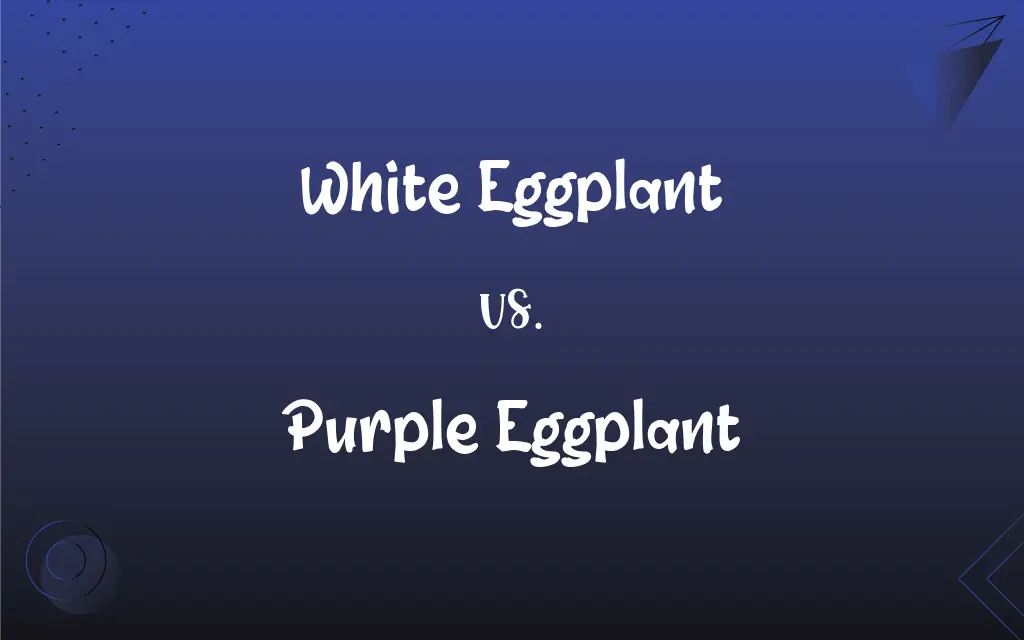White Eggplant vs. Purple Eggplant: What's the Difference?
Edited by Janet White || By Harlon Moss || Updated on October 22, 2023
White eggplant has a creamy-white skin, often milder in flavor, while purple eggplant boasts a rich purple hue and can have a stronger taste.

Key Differences
White eggplant and purple eggplant are both variants of the same vegetable, but they exhibit different colors. White eggplant, as its name suggests, comes with a smooth, creamy-white exterior. On the other hand, purple eggplant showcases a deep purple or even aubergine color which is where it gets its alternative name, "aubergine."
When it comes to flavor profiles, white eggplant tends to be milder and sometimes slightly sweeter. In contrast, the purple eggplant can have a more robust and slightly bitter taste, especially if it's not freshly harvested.
In terms of texture, both white eggplant and purple eggplant can be similar, though some argue that the white variety might be slightly creamier when cooked. The purple eggplant, popular in various cuisines, often absorbs flavors from accompanying ingredients.
There are many dishes globally where either white eggplant or purple eggplant can be used interchangeably. However, for aesthetic reasons, chefs or home cooks might opt for white eggplant in dishes where its unique color can be showcased. Purple eggplant, being more common, is usually found in traditional recipes like ratatouille or eggplant parmesan.
Cultivation practices for both white eggplant and purple eggplant are generally similar. However, depending on the region or specific variety, one might be preferred over the other due to soil compatibility or market demand.
ADVERTISEMENT
Comparison Chart
Color
Creamy-white
Deep purple/aubergine
Flavor
Milder and sometimes sweeter
Robust and sometimes bitter
Texture When Cooked
Possibly creamier
Absorbs flavors well
Common Usage
Specialty dishes
Traditional recipes
Availability
Less common
Widely available
ADVERTISEMENT
White Eggplant and Purple Eggplant Definitions
White Eggplant
An eggplant variant often considered milder in flavor.
I prefer using white eggplant for my salad because of its mild taste.
Purple Eggplant
Often found in grocery stores due to its popularity.
I grabbed a couple of purple eggplants from the local store.
White Eggplant
A vegetable that belongs to the same family as tomatoes and peppers.
Like tomatoes, white eggplant is technically a berry by botanical definitions.
Purple Eggplant
A popular variant of eggplant with a rich purple exterior.
She sliced the purple eggplant for the stew.
White Eggplant
A variety of eggplant with a smooth, creamy-white exterior.
She was intrigued by the white eggplant at the farmer's market.
Purple Eggplant
Sometimes referred to as "aubergine" in various parts of the world.
The chef asked for purple eggplant, or aubergine, for his signature dish.
White Eggplant
Often used in dishes that want to showcase its unique hue.
The dish was made vibrant with the addition of white eggplant.
Purple Eggplant
Known for its slightly robust and sometimes bitter taste.
Grilling brings out the rich flavors of the purple eggplant.
White Eggplant
A less common type of eggplant compared to its colored counterparts.
Finding a white eggplant can sometimes be a delightful rarity.
Purple Eggplant
Widely used in traditional recipes around the world.
Eggplant parmesan is made using slices of purple eggplant.
FAQs
Which eggplant type is sweeter: white eggplant or purple eggplant?
White eggplant can sometimes be sweeter than purple eggplant.
Why is purple eggplant sometimes called "aubergine"?
"Aubergine" is the British term for what Americans call "purple eggplant."
Which is more common: white eggplant or purple eggplant?
Purple eggplant is more common than white eggplant.
How should I store both white eggplant and purple eggplant?
Both should be stored in a cool, dry place, preferably the refrigerator.
Can both white eggplant and purple eggplant be grilled?
Yes, both can be grilled and used in various cooking methods.
Is the nutritional value of white eggplant different from purple eggplant?
Both are nutritionally similar, though there might be slight variations due to the pigment in purple eggplant.
How can I reduce the bitterness in purple eggplant?
Salting and letting the purple eggplant slices sit for a while can help reduce bitterness.
Can I use white eggplant in place of purple eggplant in recipes?
Yes, but there might be a slight variation in taste and appearance.
Can I grow both white eggplant and purple eggplant in my garden?
Yes, both can be grown, given appropriate climate and soil conditions.
Do both white eggplant and purple eggplant belong to the same botanical family?
Yes, both belong to the Solanaceae family, along with tomatoes and peppers.
Is the cooking time different for white eggplant and purple eggplant?
Cooking time can be similar, but it depends on the dish and preparation method.
In terms of global cuisine, where is purple eggplant more prevalent compared to white eggplant?
Purple eggplant is more prevalent in many global cuisines, especially Mediterranean, Middle Eastern, and Asian dishes. White eggplant might be more of a specialty item in some regions.
Are there dishes specific to white eggplant?
While many dishes can use either type, some might specifically use white eggplant for its color or milder flavor.
Which eggplant is better for frying: white or purple?
Both are suitable for frying, but purple eggplant might absorb more oil due to its spongy texture.
Is there a difference in seed quantity between white eggplant and purple eggplant?
Seed quantity can vary within both types depending on the specific variety and maturity.
Which eggplant is creamier when cooked: white or purple?
Some people find white eggplant to be slightly creamier, though this can vary.
Do both white eggplant and purple eggplant come in different shapes?
Yes, both come in various shapes, from round to elongated, depending on the variety.
Is the flavor of white eggplant and purple eggplant significantly different?
White eggplant tends to be milder, while purple eggplant can be more robust and sometimes bitter.
Which eggplant, white or purple, has thicker skin?
Both can have variable skin thickness depending on the variety, but purple eggplants often have slightly thicker skin.
Why might a chef choose white eggplant over purple eggplant?
A chef might choose white eggplant for aesthetic reasons or to showcase its unique hue in a dish.
About Author
Written by
Harlon MossHarlon is a seasoned quality moderator and accomplished content writer for Difference Wiki. An alumnus of the prestigious University of California, he earned his degree in Computer Science. Leveraging his academic background, Harlon brings a meticulous and informed perspective to his work, ensuring content accuracy and excellence.
Edited by
Janet WhiteJanet White has been an esteemed writer and blogger for Difference Wiki. Holding a Master's degree in Science and Medical Journalism from the prestigious Boston University, she has consistently demonstrated her expertise and passion for her field. When she's not immersed in her work, Janet relishes her time exercising, delving into a good book, and cherishing moments with friends and family.
































































